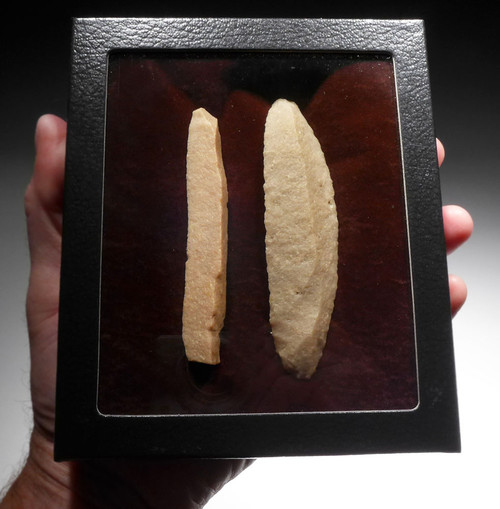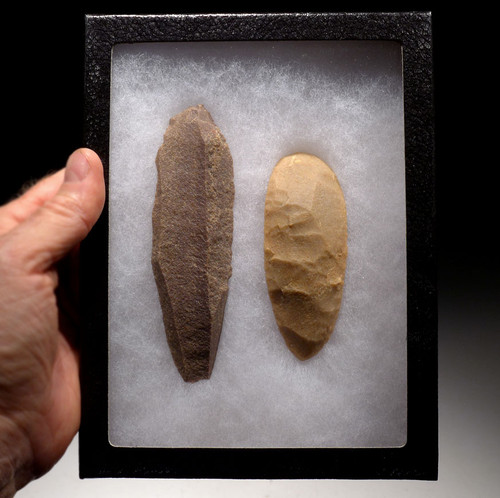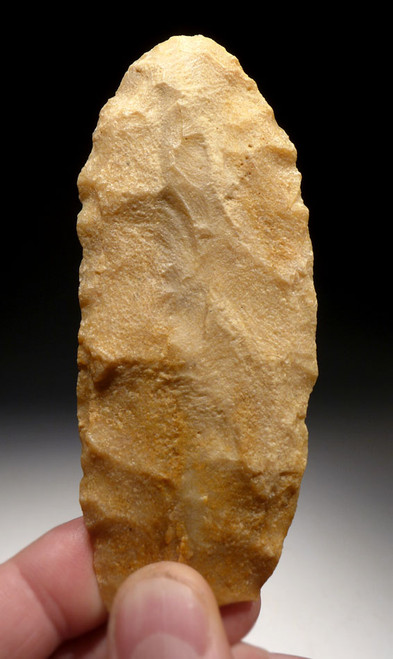Product Description
SEE MORE AFRICAN NEOLITHIC TOOLS AND ARTIFACTS
On a dinosaur fossil-hunting expedition in 2000 by a team of scientific explorers led by Paul Sereno, a paleodune and ancient lakebed site was discovered that yielded over 200 ancient burials of Kiffian and Tenerian people. The scientific findings showed that this region was once a humid lake region that was home to these hunter-fisher-gatherer people. The area became known as the "Green Sahara" for its once fertile and habitable landscape. Noted paleontologist, Dr. Paul Sereno, famous for other Saharan dinosaur discoveries, shot into the archaeological spotlight with his discovery of the ancient lakebed cemetery at Gobero in Niger in the year 2000. Interred in the many burials were numerous stone tools, ceramics, shells, beads and bone harpoons typical for the lifestyle of these ancient people of the Green Sahara. This exceptional AUTHENTIC artifact is similar to the specimens found at Gobero. It comes from the same period of the Tenerian Neolithic Culture and region now made famous by this discovery.
This large MUSEUM-CLASS ground and grooved stone bead polisher is an example of a scarce tool used to manufacture and polish stone beads and pendants in the Tenerean Neolithic Culture. Of the few of these we acquired in the last 25 years, this was the top specimen of our collection! More commonly seen in the Neolithic Capsian Tradition to the further north and west, we have seen much lesser of these objects coming from the Tenerean Neolithic.
To make a bead, the gem material would first be roughly formed. It then would have then been rubbed back and forth in the grooves of this tool with the aid of sand slurry, to smooth and polish the stone into a bead or pendant. Different grooves might have been used for different sizes of grit, allowing a rougher polish in one groove and a finer polish in the other. The region where these rare artifacts were once found is now completely off-limits due to the laws prohibiting export, as well as the danger of the area due to terrorism, crime and war, making objects like this increasingly rare and valuable!
We have seen numerous fake examples of these in the marketplace. When examined under magnification, fakes will have evidence of modern grinding marks on the surface in the grooves, and lack microscopic crevices impacted with ancient mineral deposits. An authentic example like the one offered here, will lack ANY evidence of recent grinding marks and withstand close examination under a microscope.
HISTORY
The Earth has been warming and cooling for millions of year, well long before humans were on the planet. One of the most dramatic examples of climatic change in the last 10,000 years is the desiccation of what is now the Sahara desert. Prior to as recent as 3000 B.C., the South Central Sahara region in Africa was a humid lake savannah. It was home to a thriving culture of ancient humans known as the Tenerians and before them, the Kiffians. The occupation of this area by these two peoples occurred continuously from around 7700 B.C. to the drying of the Sahara in 2500 B.C..
In the final Pleistocene and early Holocene Periods around 10,000 years ago, the South Central Sahara Desert was once a highly favorable environment for hunters, gatherers and pastoralists. Freshwater lakes existed between the dunes in what is now the Tenere region, Lake Chad was eight times its current size, the highlands supported Mediterranean forest trees, and a diverse variety of both large and small fauna flourished there. The slow drying out process of the Sahara, began 7,000 years ago and ended 4500 years ago resulting in the barren conditions that exist to this day. As we progress through time from the end of the Pleistocene towards the end of the Neolithic Period there, we see humans relying more on meat from raised animals as opposed to hunted animals that once roamed wild in the formerly Green Sahara.
 US DOLLAR
US DOLLAR
 EURO
EURO
 AUSTRALIAN DOLLAR
AUSTRALIAN DOLLAR
 CANADIAN DOLLAR
CANADIAN DOLLAR
 POUND STERLING
POUND STERLING




























